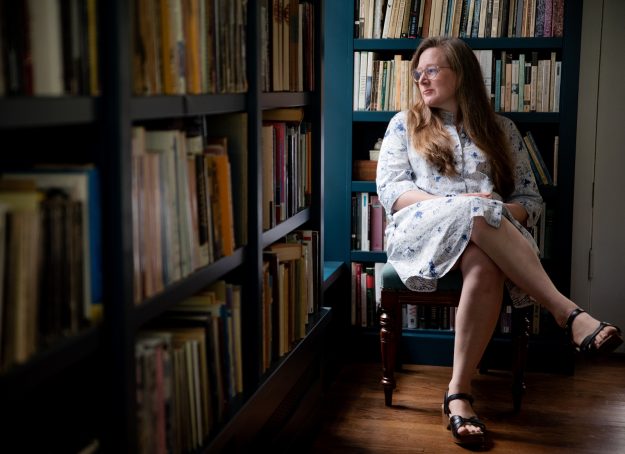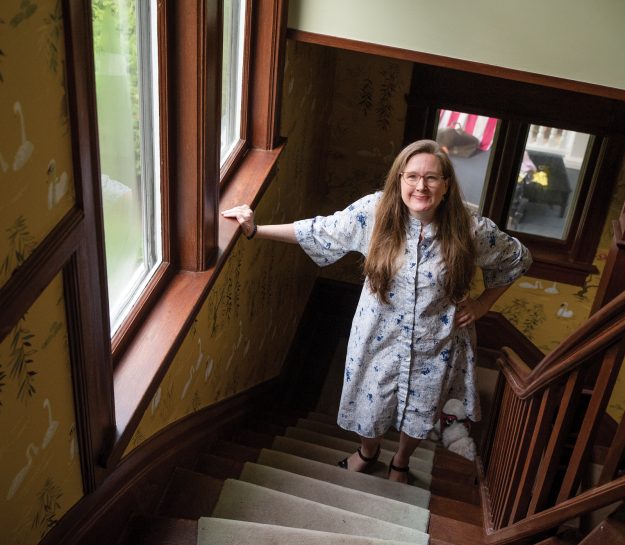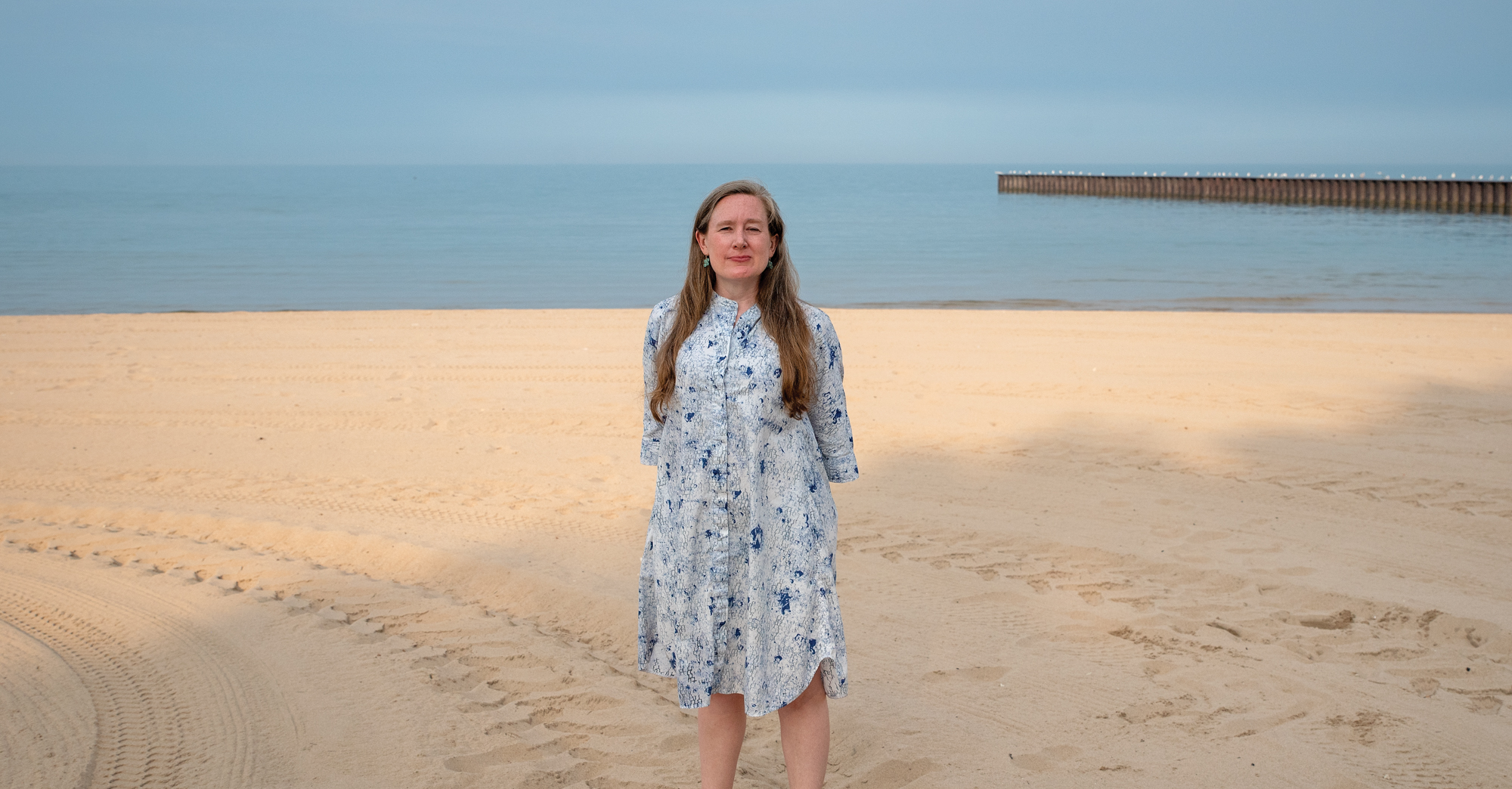Sarah Ruhl was diagnosed with Bell’s palsy, a paralysis of the seventh cranial nerve (which controls facial muscles), shortly after her twins, William and Hope, were born in 2010. For most people the condition is temporary and usually disappears completely within six months. But for an unlucky minority of those afflicted—like Ruhl—the condition may persist.
Smile: The Story of a Face, published last month by Simon & Schuster, recounts the award-winning playwright’s ten-year struggle to understand and ultimately accept a situation over which she had little or no control. Visits to acupuncturists, neurologists, neurosurgeons, and physical therapists are part of the story, of course, but Ruhl, with her “broken face,” also reflects on a culture—and a profession—that places a high and often complex premium on appearances, especially for women and mothers.
The following is culled from my conversation with Sarah on July 28, 2021, as the Metropolitan Opera was preparing for their November production of Eurydice, a recent adaptation of Sarah’s 2003 play featuring music by Matthew Aucoin and a libretto by Sarah. We discussed her unique story and the role that Tibetan Buddhism played in her becoming, as she says near the end of the book, “more better.”
– Ronn Smith, author and director
*****
Ronn Smith (RS): I’d like to start with the first sentence of the book: “Ten years ago, my smile walked off my face, and wandered out in the world. This is the story of my asking it to come back.” So my first question is: Why this story, and why now?
Sarah Ruhl (SR): It wasn’t a story I necessarily wanted to tell, but Tony, my husband, saw that I was resisting writing about it. Being a good psychiatrist, he said, “You think about it all the time. You never write about it, or talk about it. What if you tried?” And I somewhat reluctantly thought, “All right, I’ll try.” Once the book proposal was written, which happened very quickly, I just kept writing. Selfishly, the reason to write it was to dig myself out of a hole. I had been telling myself a story about my health and my face in an ossified way, and I needed to change the narrative. The less selfish part of the story was that I wished I’d had a book about this subject matter when I was going through the illness, especially early on. I hope the book is a comfort to people who are going through something equally chronic or disappointing.
And “why now?” With all my theater productions closed as a result of the pandemic, I finally had time to write long-form nonfiction. It was interesting looking at the material while we were isolated, wearing masks, when a lot of people were thinking about the world and illness and health in a different way. For some of us, we bump up against illness all the time, but a large swath of the population may not think about illness most of the time. Everything goes back to the four noble truths. We’re all about to be sick, we’re all about to die. That reality is staring us in the face in an unusual way right now during this pandemic.
“I had been telling myself a story about my health and my face in an ossified way, and I needed to change the narrative.”
RS: The masks encouraged a sort of social distancing, didn’t they? As soon as we were able to take them off, we could see each other’s faces. It was a bit easier to connect.
SR: I remember that first weekend in Brooklyn, when we were allowed to walk around outdoors without the masks. There was an invitation that wasn’t exactly there when we were all masked. You make eye contact, you smile, and then you engage in conversation. The eyes create permission, but the mouth is needed to unlock the second gate of permission for the interaction to occur. Similarly, with the Bell’s palsy, I felt keenly: How do I create permission to talk to people, to strangers?
RS: At one point in the book you write about wanting to walk away from your body and face, and then later, that you came to love your face. I wonder how you came to that realization, and if this in some way reflects your Buddhist practice.
SR: A lot of what I was doing during the early part of the diagnosis was just flat-out denial. I thought: “There is nothing I can do about this, so I will live in my mind, make art, have a spiritual practice.” But it was a spirituality that was not embodied. It interests me that the body is involved in meditation practice. Ideally, you’re not trying to be disembodied when you’re sitting. You are in your body, in your breath. I was on a path toward not seeing my body as a source of joy or a source of discovery. Being honest with myself meant I had to admit how much I did think about my condition. I was disappointed, and I was ashamed of being disappointed. But that seemed like a kind of failure too—as a feminist, as a writer, as someone who cares about the invisible world. I thought I shouldn’t care about my face. But I did care.

RS: We live in a world where the visible is highly valued, especially in the theater. The thing about playwrights and directors is that they don’t stand on stage being watched for two hours.
SR: Directors and playwrights are in this fascinating position: we are not looked at, but we get to do the looking. We are very aware of the body and the face. We judge actors when they walk into a room based on the gestalt of the body. The theater is a fascinating confluence of the visible and invisible worlds.
RS: Tibetan Buddhism, either directly or indirectly, plays a large part of this story, and a key figure here is Yangzom, your babysitter.
SR: I met Yangzom when Anna was a baby, about fifteen years ago. Meeting her was an introduction to Tibetan Buddhism, put into practice. Yangzom is so patient with the kids, so compassionate, and at any given moment I could see she was thinking, “What can I do to be helpful?” She’s always helping others. If she has a weekend, she’s helping Tibetan immigrants get acclimated, or helping at a temple in Queens, or cooking for somebody who has a sick family member. Because I write at home, I’d often see Yangzom during the day, and she’d tell me little bits of dharma. She’d tell me about her life story, or tell me a story the monks told her. It was as though Tibetan Buddhism just walked into my house.
RS: How do you reconcile your interest in Tibetan Buddhism with your Catholic upbringing, which you discuss in the book?
SR: Tibetan Buddhism feels familiar to me as a Catholic—maybe because of the pageantry and incense? Yangzom made my home feel more like a home. And finding a spiritual practice that made sense to me made my home feel more like a home. Also, my husband’s father was Thai, so, between the cultural inheritance of Theravada Buddhism, and then Tibetan Buddhism and the Catholicism of my childhood, we’re a very ecumenical home.
RS: Yangzom is presented as one of several core teachers in the book, but there are others, like Paula Vogel, your playwriting teacher at Brown University, and Khenpo Pema Wangdak. Lama Pema attended a rehearsal for The Oldest Boy, your play about an American mother and a Tibetan father with a 3-year-old son who is believed to be the reincarnation of a Buddhist lama. During your time together, Lama Pema said, “Art and religion aren’t very different. And someone has to do it.” How did you feel about that statement then, Sarah, and how do you feel about it now?
SR: I thought it was funny when he said it, and I continue to think it’s funny. It’s funny because it’s true. Art is part of our culture, and someone has to do it. Part of our community needs to make art for the health of the community—someone needs to do the work of culture. Both art and religion are about the invisible world. When you’re missing that element in the culture, you’re left with a fearful hunger. That is the thing about artists as essential workers. Obviously we are not essential workers in terms of the coronavirus itself, but as artists we do mark passages, create mourning rituals, mark grief in the culture—and that is indispensable. Talking with different monks over the years has helped me understand how art can be helpful.

RS: I’d like to talk about another of your teachers, Max Ritvo, with whom you co-authored Letters from Max: A Book of Friendship, published in 2019. Max was a gifted poet you accepted into your playwriting class at Yale University. He died of pediatric cancer at the age of 25.
SR: Yes.
RS: You met Max two years after the twins were born, so you were dealing with Bell’s palsy at that time. Yet there is little about that in your correspondence with Max. I’m wondering why.
SR: I was still in the “This doesn’t exist” phase of my Bell’s palsy. I had an intellectual, spiritual connection with Max that didn’t require a body. He was certainly suffering a great deal in his body, and I was observing that. And there was no denial of the body in Max’s poetry. I hope I learned something from that, but I don’t know how to put into words what I learned.
“I do think writing is about writing, but it’s also not about writing. It’s about living, exposure, vulnerability, love.”
RS: Another thing that interests me about your writing—in the plays as well as in 100 Essays, Letters from Max, and now Smile—comes from a story you relate about an actor who complained during one of the rehearsals that there was nowhere to hide on the set. You acknowledge that there were no pillars to hide behind, but you also realized that there was no language for the actor to hide behind. I think the real pleasure your writing gives me is how transparent it is. I don’t ever feel that you’re holding back or playing games, or hiding behind the language. There’s something very clear about your writing, especially in Smile, where you’re dealing with a complicated, sensitive subject. Does this in some way relate to your Buddhist practice?
SR: I’m from the Midwest, and I like plain language. I don’t like seeing a writer play games, or hide behind cleverness. I do think writing is about writing, but it’s also not about writing. It’s about living, exposure, vulnerability, love.
RS: You also tend to write about simple, mundane things.
SR: I think so much of poetry starts there. You can’t go straight to the sublime, you need an approach. And the approach is through a teacup or an animal cracker or washing your hands. You can’t just walk up to the sublime and say “Talk to me.” We need these little portals through which we have access and make metaphors. Theater can be allergic to the mundane; instead, there can be a desire for plot and bigness. But I like wondering about the mundane in the theater: what’s quiet, what’s humble—how can that be staged?—those little moments.
RS: Are there any playwrights or writers who you think are particularly good at the mundane?
SR: Anton Chekhov. All the weird little moments in Chekhov that don’t add up. They’re so beautiful, like life. In Ariane Mnouchkine’s cycle The Last Caravansary (Odysseys), which was presented at the Lincoln Center Festival in 2005, she had children pass out lemonade during an intermission. There also was a beautiful silent scene of kids at the beach all day; they were exhausted, and a parent carried the sleeping children home and put them to bed. It felt so familiar. I could feel that in my body, of being a tired child at the end of a long day. And being a parent. It was so small, and so tender, and it wasn’t a part of any grand narrative. It felt like life to me. It felt like finding the spiritual in the apparently mundane.
RS: What are you working on now?
SR: I’m contemplating what the next play will be. It’s hard for me to write theater while the theater is, in a way, gone. But I’ve been writing a haiku a day during the pandemic, and that will become a book. Do you know the work of John Paul Lederach, an American scholar internationally known for his work in peacemaking and conciliation? He has a haiku practice, and he sees poetry as a kind of peacemaking. He says that, though it’s never been scientifically proven, a serious approach to life doesn’t teach you more than a playful approach to life. Haiku can teach you a playful approach to life. Writing haiku was a beautiful way to mark time in the pandemic, and to observe the natural world. The theaters were shut down, which was hard for me because the theater is such a huge part of my life, so I thought, “Let nature be my culture for the moment.” And the moment was longer than we thought.
Thank you for subscribing to Tricycle! As a nonprofit, we depend on readers like you to keep Buddhist teachings and practices widely available.
